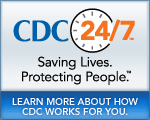MMWR News Synopsis
Friday, April 26, 2019
- Consumption of Alcohol Beverages and Binge Drinking Among Pregnant Women Aged 18–44 Years — United States, 2015–2017
- Preliminary Incidence and Trends of Infections with Pathogens Transmitted Commonly Through Food — Foodborne Diseases Active Surveillance Network, 10 U.S. Sites, 2015–2018
- Hepatitis C Virus Potentially Transmitted by Opioid Drug Diversion from a Nurse — Washington, August 2017–March 2018
- QuickStats
- Surveillance Summaries
Consumption of Alcohol Beverages and Binge Drinking Among Pregnant Women Aged 18–44 Years — United States, 2015–2017
CDC Media Relations
404-639-3286
Alcohol exposure during pregnancy can cause birth defects and developmental disabilities collectively known as fetal alcohol spectrum disorders (FASDs). Alcohol exposure is also linked to other negative pregnancy and birth outcomes, such as miscarriage and stillbirth. One in 9 pregnant women ages 18-44 years reports drinking alcohol in the past 30 days. Interventions at the community and clinical level may decrease alcohol use during pregnancy and lead to fewer FASDs and other negative pregnancy outcomes. Drinking alcohol during pregnancy can cause fetal alcohol spectrum disorders (FASDs). This analysis of 2015–2017 Behavioral Risk Factor Surveillance System data found that 1 in 9 (11.5%) pregnant women ages 18–44 years in the United States reported drinking alcohol in the past 30 days. Among pregnant women who reported consuming alcohol, one third engaged in binge drinking – defined as four or more drinks on at least one occasion. Screening for alcohol use combined with brief counseling by healthcare providers may decrease alcohol use during pregnancy and reduce the risk of FASDs and other negative pregnancy and birth outcomes.
Preliminary Incidence and Trends of Infections with Pathogens Transmitted Commonly Through Food — Foodborne Diseases Active Surveillance Network, 10 U.S. Sites, 2015–2018
CDC Media Relations
404-639-3286
Targeted prevention measures are needed on produce farms, food animal farms, and in meat and poultry processing establishments to make food safer and decrease human illnesses. According to 2018 preliminary surveillance data from the Foodborne Diseases Active Surveillance Network (FoodNet), Campylobacter – most often linked to chicken — has been the most commonly reported bacterial foodborne infection since 2013. Salmonella is the second most common, and the incidence of infection has not declined in recent years. Infections caused by a type of Salmonella called Salmonella Enteritidis have not declined in more than 10 years, despite regulatory programs intended to reduce Salmonella in chicken and eggs, both of which are important sources of this foodborne pathogen.
Hepatitis C Virus Potentially Transmitted by Opioid Drug Diversion from a Nurse — Washington, August 2017–March 2018
Julie Graham
Communications, Washington State Department of Health
Phone: (360) 810-1628
Email: Julie.Graham@DOH.WA.GOV
A recent hepatitis C outbreak in Washington was caused by a healthcare provider diverting drugs from patients for personal use. Drug diversion endangers patient safety. During investigation of a 2018 outbreak of hepatitis C in a Washington state emergency room, disease detectives identified 13 recent patients with similar hepatitis C infections. Evidence pointed to drug diversion by one of the patients’ healthcare providers. Drug diversions happen when a healthcare provider uses a patient’s controlled substance (such as opioids) for personal use. Diversion and tampering can expose patients to infections such as hepatitis C. The hospital’s drug dispensing log identified a nurse who accessed drugs at a higher than average frequency. The nurse had treated all 13 patients. Ultimately, the nurse admitted diverting patients’ drugs, and the outbreak was stopped. Healthcare facilities should actively monitor how controlled substances are used and should conduct investigations whenever they suspect diversion activities may be occurring. Report drug diversions to authorities and identify patients who may be affected so they can be linked to care if needed.
###
U.S. DEPARTMENT OF HEALTH AND HUMAN SERVICES
CDC works 24/7 protecting America’s health, safety and security. Whether diseases start at home or abroad, are curable or preventable, chronic or acute, or from human activity or deliberate attack, CDC responds to America’s most pressing health threats. CDC is headquartered in Atlanta and has experts located throughout the United States and the world.

